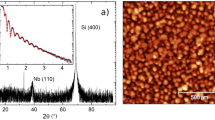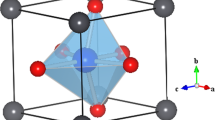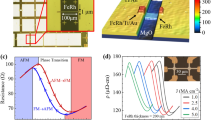Abstract
IT is well known1 that the magnetization reversal mechanism in a thin ‘Permalloy’ film is related to the degree to which a truly uniaxial anisotropy can be induced on a microscopic scale. Once the magnetostrictive and crystal anisotropy has been minimized by carefully controlling the composition of the film, the surface morphology of the substrate on which the NiFe is to be deposited can play a dominant part in determining Hc and HK and the angular dispersion of the easy axis of magnetization. In magnetic memory applications it is expedient to deposit the ‘Permalloy’ film on to a highly conducting metal ground plane which will be in close proximity to the memory bits in order to reduce both the memory noise and the drive power of the memory array. However, in practice it has not been possible to deposit a thin NiFe film directly on to such a metal ground plane and obtain uniform magnetic properties over large substrate areas, that is, 100 cm2. Magnetic and electron microscopy investigations have shown2 that this is partially due to the fact that mechanical polishing techniques cannot adequately produce the smooth surface characteristics necessary to avoid the inhibition of domain wall motion. In addition, recent work in this laboratory on sputtered NiFe films on very highly polished Ag or Ag.Cu or Au metal planes has shown that significant amounts of the face-centred cubic NiFe diffuses into these face-centred cubic metal substrates during deposition in the glow discharge, resulting in completely isotropic magnetic films. These problems can be overcome by depositing an intermediate layer which is thick enough to serve both as a diffusion barrier which does not replicate the topography of the underlying metal ground plane and at the same time has a minimum of granular structure of its own3. An evaporated SiO film, > 10,000 Å, can adequately fulfil these needs2; however, reproducibility over large areas is difficult. The chemistry of SixOy vaporization and the susceptibility of this material to gettering reactions at the substrate with the associated microscopic morphology and anisotropic film stress4 problems all lead to a rather complex system to control accurately. Relatively few alternative thin film materials will adequately fulfil the diffusion barrier and morphology requirements in the deposition temperature-range, 300°–400° C, found necessary5 for uniaxial anisotropy sputtered NiFe films. The possibility of using a thin film of a refractory metal such as tantalum was considered since this would have a low surface mobility on the metal ground plane and would be less susceptible to formation of large granules during the NiFe deposition. Alloying of NiFe with body-centred cubic refractory metals should also not be as serious a problem.
This is a preview of subscription content, access via your institution
Access options
Subscribe to this journal
Receive 51 print issues and online access
$199.00 per year
only $3.90 per issue
Buy this article
- Purchase on Springer Link
- Instant access to full article PDF
Prices may be subject to local taxes which are calculated during checkout
Similar content being viewed by others
References
Coren, R. L., J. App. Phys., 35, 201 (1964).
Bertelsen, B. I., J. App. Phys., 33, 2026 (1962).
Fisher, R. D., and Haber, H. E., Nature, 199, 164 (1963).
Caswell, H. L., and Priest, J., J. App. Phys., 34, 247 (1963).
Kay, E. (to be published).
Crowther, T. S., Lincoln Lab. Group Rep. No. 51–2 (Feb. 1959).
Author information
Authors and Affiliations
Rights and permissions
About this article
Cite this article
KAY, E. Uniaxial Anisotropy ‘Permalloy’ Films grown in a Glow Discharge on Sputtered Tantalum Substrates. Nature 202, 788–789 (1964). https://doi.org/10.1038/202788b0
Issue Date:
DOI: https://doi.org/10.1038/202788b0
Comments
By submitting a comment you agree to abide by our Terms and Community Guidelines. If you find something abusive or that does not comply with our terms or guidelines please flag it as inappropriate.



